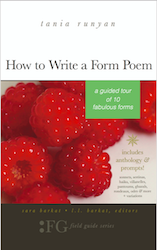Poet-a-Day: Meet Tom C. Hunley
I’ve had the pleasure of knowing poet Tom C. Hunley for many years. We’ve enjoyed celebrating (and, yes, commiserating) together over many of our common experiences, including writing poetry, parenting teens, and playing music. Hunley is a prolific poet and experienced instructor, so I was thrilled when he sent me his sonnet, “It’s Not so Hard to Write a Sonnet, Man” for inclusion in How to Write a Form Poem.
Here are the first five lines of his sonnet. Want to read more? You can find the whole poem in the sonnet chapter of How to Write a Form Poem.
It’s not so hard to write a sonnet, Man (excerpt)
It’s not so hard to write a sonnet, Man.
Write of a loving couple paired like rhyme.
Let them get old, but not their love, and scan
your lines so that they dance in time,
the lines, I mean, but yes, the lovers, too…
—Tom C. Hunley
Here’s what the poet has to say about his poem:
Tania Runyan (TR): Tell me a little about the origin story of “It’s Not So Hard to Write a Sonnet, Man.”
Tom C. Hunley (TCH): A lot of my poems are what I call “stylistic collisions” that come from mashups of techniques observed in others’ poems. (You can read more about this in my textbook, The Poetry Gymnasium: 110 Proven Exercises to Shape Your Best Verse).
Below are my observations of poems by Mark Halliday and Tony Hoagland, followed by the self-assignment that led to “It’s Not So Hard to Write a Sonnet, Man”:
Stylistic Collision: “Elegy” by Tony Hoagland and “Yearbook” by Mark Halliday
• What I Notice/Like in “Elegy”: It opens “It’s easy to write an elegy.” It contrasts writing an elegy with harder things: driving a car, opening a can of soup, keeping loved ones alive. It then compares love to a battle and an elegy to something that happens in the quiet moments after the battle. Living is described through all the mundane household duties like paying rent, washing dishes, and grocery shopping. Writing an elegy is then “to move out / and leave only the elegy behind, / like a sponge or a mop, or a roll of towels // or a bowl of fresh water / you place on the cleaned up floor / after your precious dog has gone.”
• What I Notice/Like in “Yearbook”: Written in the plural first person “We” POV, this poem is a sorry/not sorry poem from a Yearbook committee that messed up some captions and some photos, though they do want to point out that “this new Yearbook will be a wad of ash at the bottom of an incinerator / or else an ancient text as strangely fictive and absurdly remote / as Beowulf seems to your most unimaginative classmates.”
• Self-Assignment: Write a sonnet about how it’s easy to write a sonnet. Compare it to the difficulty of captioning wedding and funeral announcements in the local paper (and, by extension, to keeping a marriage and a life going).
TR: What usually comes first for you: the form or the content? What factors determine how you go about making that choice?
TCH: If I’m trying to learn a new form, the form comes first. Once a form is part of my toolbox, content comes first. I just reach for the form that best expresses that content.
TR: What do you hope poets can learn from a book like How to Write a Form Poem?
That aspiring poets need to be just as committed as other artists. Musicians need to learn their scales and modes; we need to learn our forms and techniques. No shortcuts.
About Tom C. Hunley
Tom C. Hunley teaches poetry writing at Western Kentucky University. He won the 2020 Rattle Chapbook Prize for his manuscript Adjusting To The Lights and he has poems forthcoming in The Finger Literary Journal, Gargoyle, The Penn Review, Pittsburgh Poetry Journal, and Tipton Poetry Journal.
Photo by Tambako the Jaguar, Creative Commons, via Flickr. Post by Tania Runyan.
Browse more Poet-a-Day
Browse 50 States of Generosity
Check out The Yellow Wall-paper Graphic Novel
______________
How to Write a Form Poem: A Guided Tour of 10 Fabulous Forms

You’ll also be entertained by Runyan’s own travel stories that she uses to explain and explore the various forms—the effect of which is to bring form poetry down to earth (and onto your own poetry writing map)!
BUY HOW TO WRITE A FORM POEM NOW!
- Flowers of California: California Poppy - December 8, 2022
- Flowers of California: Lily of the Nile - October 13, 2022
- Flowers of California: Crape Myrtle - October 5, 2022


Megan Willome says
“No shortcuts” should be on a T-shirt.